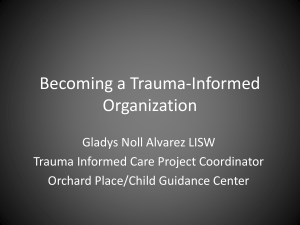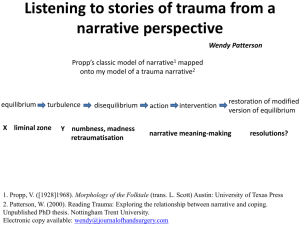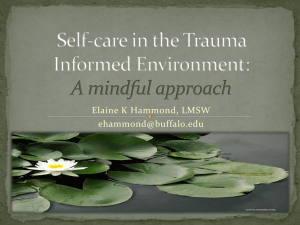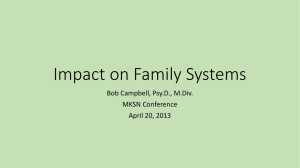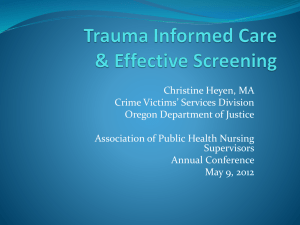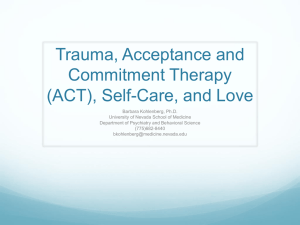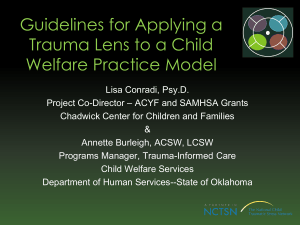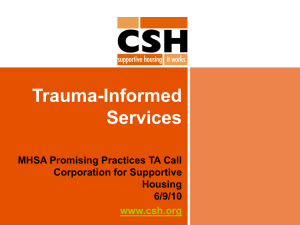File - 2014 Trauma Informed Care Conference
advertisement
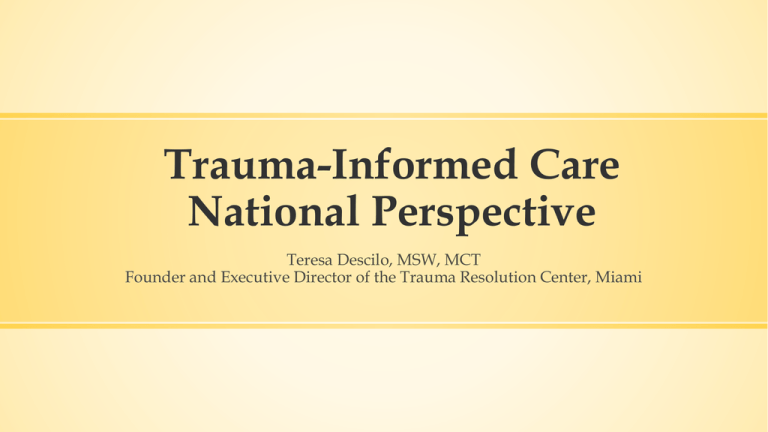
Trauma-Informed Care National Perspective Teresa Descilo, MSW, MCT Founder and Executive Director of the Trauma Resolution Center, Miami Overview ▪ Define the six key principles of a trauma-informed approach and what this will mean for service providers ▪ The focus on and importance of early detection and adequate intervention ▪ Moving ahead in a mindful way SAMHSA’s Definition of Trauma Individual trauma results from an event, series of events, or set of circumstances that is experienced by an individual as physically or emotionally harmful or life threatening and that has lasting adverse effects on the individual’s functioning and mental, physical, social, emotional, or spiritual well-being. SAMHA’s Concept of Trauma and Guidance for a Trauma-Informed Approach ▪ Unresolved trauma is a public health issue ▪ It has no boundaries of race, age, gender, socioeconomic status, ethnicity, geography or sexual orientation ▪ It is a universal experience for those with substance abuse, mental health issues and chronic diseases ▪ Addressing trauma requires a multi-pronged, multi-agency public health approach ▪ It will require public education and awareness, prevention and early identification and effective trauma-specific assessment and treatment The Current Paradigm ▪ Officer Krupke Multiple Service Sectors Group 1 ▪ Not just mental health and substance abuse 1. Criminal justice 2. Social welfare 3. Education 4. Primary care 5. Military Group 5 Multiple Service Sectors Group 4 Group 2 Group 3 The Impact of the Existing Paradigms ▪ Many are trauma-inducing ▪ Seclusion and restraints ▪ Punishing traumatized kids who act out ▪ Victimizing the victims ▪ No compassion for those who have traveled the path of unresolved trauma to the harsh outcomes that are inevitable for many. Most offenders started off as victims. When trauma triggers, the choice is to experience the trauma as a victim or perpetrator. Sometimes we slip into ‘offender’ as it is less painful to experience than ‘victim’. The Shift A program, organization, or system that is traumainformed realizes the widespread impact of trauma and understands potential paths for recovery; recognizes the signs and symptoms of trauma in clients, families, staff, and others involved with the system; and responds by fully integrating knowledge about trauma into policies, procedures, and practices, and seeks to actively resist retraumatization The Four “R’s”: Key Assumptions in a Trauma-Informed Approach ▪ Realization of the widespread impact of trauma ▪ Individuals, families, groups, organizations and communities. Behaviors understood from the context of trauma, as coping ▪ Recognize signs of trauma – across age, gender, culture ▪ Respond ▪ All staff understands TIC and responds appropriately ▪ Evidenced-based Trauma-specific services available ▪ Policies, handbooks, manuals promote resilience, recovery and healing from trauma ▪ Re-Traumatization ▪ Doesn’t retraumatize staff as well as clients Six Key Principles of a Trauma-Informed Approach ▪ Safety ▪ Trustworthiness and Transparency ▪ Peer Support ▪ Collaboration and Mutuality ▪ Empowerment, Voice and Choice ▪ Cultural, Historical and Gender Issues Harris, M. & Fallot, R. (2001) & Bloom, S. (2012) Safety, Trustworthiness and Transparency, Peer Support ▪ throughout the organization, staff and the people they serve feel physically and psychologically safe; the physical setting is safe and interpersonal interactions promote a sense of safety. ▪ organizational operations and decisions are conducted with transparency and the goal of building and maintaining trust among staff, clients, and family members of people being served by the organization. ▪ are integral to the organizational and service delivery approach and are understood as a key vehicle for building trust, establishing safety, and empowerment. Collaboration and Mutuality Empowerment, Voice and Choice Cultural, Historical and Gender Issues ▪ there is true partnering and leveling of power differences between staff and clients and among organizational staff from direct care staff to administrators; there is recognition that healing happens in relationships and in the meaningful sharing of power and decision-making. ▪ the organization aims to strengthen the staff's, clients', and family members' experience of choice and recognize that every person's experience is unique and requires an individualized approach. ▪ the organization addresses cultural, historical, and gender issues; the organization actively moves past cultural stereotypes and biases (e.g. based on race, ethnicity, sexual orientation, age, geography, etc.), offers gender responsive services, leverages the healing value of traditional cultural connections, and recognizes and addresses historical trauma. What will this mean for you as a service provider? ▪ How will this impact your immediate work environment? ▪ How will this impact services that are delivered? ▪ Will the method of delivery change? If so, how? ▪ How will you address eliminating power differentials? ▪ What are some of Mississippi’s special needs? Healing Starts With Us Avoidance and Denial ▪ Are kinda normal for us – part of the human condition- coping skill ▪ Won’t work in the context of resolving trauma ▪ If we aren’t feeling safe, resolved, strong, our clients will know ▪ Our work environments are a product of each individual The Importance of Self-Care ▪ ▪ ▪ ▪ ▪ ▪ ▪ Not a luxury- An imperative ethical responsibility Effectively deal with your own stuff Rest, exercise, eat well Keep a balance in your life with spirit, mind, body Establish a life view that works for you Advocate for changes in the areas that most impact you Make sure that your clients can receive effective help – closure Employer’s Responsibility ▪ ▪ ▪ ▪ Vary caseload Vary activities Provide stress-reduction activities Create a pleasant work environment ▪ My job description includes that I take care of my staff. ▪ SAMHSA consultants have interviewed me twice about our staff care policies and practices to inform national policy. The Focus on and Importance of Early Detection and Adequate Intervention ▪ The Adverse Childhood Experiences Study ▪ Trauma Spectrum Disorders ▪ Stress Diseases ▪ SAMHSA’s General Adult Trauma Screening and Brief Intervention (GATSBI) Borrowing from Lisa Najavits, Ph.D ▪ Phases of Recovery ▪ Stage 1: Safety (present) ▪ Stage 2: Mourning (past) ▪ Stage 3: Reconnection (future) (adapted from Herman, Trauma and Recovery, 1992) ▪ Seeking Safety Focus only on First phase treatment Safety Adequate Intervention ▪ Decide what your goals are as far as providing healing experiences for your clients. Cope and manage, feeling better or a new, higher functioning normal? ▪ Functional/complementary/holistic medicine. Some of the Initiatives From Across the Country ▪ Vermont -Bill includes trauma screening in health evaluation of adults ▪ Maine’s “Thrive Initiative” incorporates a trauma-informed care focus for children ▪ New York – introducing a trauma-informed initiative in the JJS ▪ Florida – JJS adopting trauma-informed care. TIC knowledge is a requirement for agencies receiving state mental health and substance abuse funds ▪ Connecticut – Multiple state agencies are collaborating to build a traumainformed system of care ▪ Tarpon Springs, FL – the first US trauma-informed city Explosion of Information ▪ Google – Trauma Informed Care – 17,000,000 results one month ago. 38,600,000 results on September 3! ▪ Certificate in Trauma Informed Care – 471,000 results! Moving Ahead in a Mindful Way ▪ Trauma Informed Care is now a ‘sexy cause’ ▪ Accept that the paradigm is changing – business as usual hasn’t worked ▪ Need to define what constitutes TIC ▪ Need to define what is sufficient for Trauma Specific Care ▪ Funders need to educate themselves about trauma and effective services and be willing to let go of what hasn’t worked. The secret of change is to focus all your energy, not on fighting the old, but on building the new. Socrates IMAGINE A World Where No One is Acting Out of Their Past Wounds
